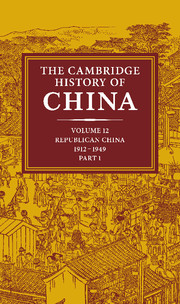Book contents
- Frontmatter
- 1 Introduction: Maritime and continental in China's history
- 2 Economic trends, 1912–49
- 3 The foreign presence in China
- 4 Politics in the aftermath of revolution: the era of Yuan Shih-k'ai, 1912–16
- 5 A constitutional republic: the Peking government, 1916–28
- 6 The warlord era: politics and militarism under the Peking government, 1916–28
- 7 Intellectual change: from the Reform movement to the May Fourth movement, 1895–1920
- 8 Themes in intellectual history: May Fourth and after
- 9 Literary trends I: the quest for modernity, 1895–1927
- 10 The Chinese Communist Movement to 1927
- 11 The Nationalist Revolution: from Canton to Nanking, 1923–28
- 12 The Chinese bourgeoisie, 1911–37
- Bibliographical essay
- Bibliography
- Index
- Republican China – physical features
- References
6 - The warlord era: politics and militarism under the Peking government, 1916–28
Published online by Cambridge University Press: 28 March 2008
- Frontmatter
- 1 Introduction: Maritime and continental in China's history
- 2 Economic trends, 1912–49
- 3 The foreign presence in China
- 4 Politics in the aftermath of revolution: the era of Yuan Shih-k'ai, 1912–16
- 5 A constitutional republic: the Peking government, 1916–28
- 6 The warlord era: politics and militarism under the Peking government, 1916–28
- 7 Intellectual change: from the Reform movement to the May Fourth movement, 1895–1920
- 8 Themes in intellectual history: May Fourth and after
- 9 Literary trends I: the quest for modernity, 1895–1927
- 10 The Chinese Communist Movement to 1927
- 11 The Nationalist Revolution: from Canton to Nanking, 1923–28
- 12 The Chinese bourgeoisie, 1911–37
- Bibliographical essay
- Bibliography
- Index
- Republican China – physical features
- References
Summary
The time between 1916 and 1928 is commonly called the ‘warlord period,’ and its politics can be analysed from two points of view. The view from the provinces requires a study of regional militarism, while the view from the centre calls for examination of constitutional and military struggles in Peking. These two views will help us appraise the place of warlordism in modern Chinese history.
THE VIEW FROM THE PROVINCES: WARLORDS AND WARLORDISM
Most simply, a ‘warlord’ was one who commanded a personal army, controlled or sought to control territory, and acted more or less independently. The Chinese equivalent – chün-fa – is opprobrious, suggesting a selfish commander with little social consciousness or national spirit; some argue that ‘regional militarist’ is a more neutral term for the diverse personalities found among the military leaders of the time. Others argue that ‘warlord’ is more appropriate in its connotations of violence and usurpation of civil authority. In any event, it was ‘the kind of authority he exercised and not his goals that distinguished the warlord.’ Since many leading warlords held the position of military governor of a province, the term tu-chün is used as a rough synonym for warlord or regional militarist.
The warlords were a diverse lot, and most generalizations about their character and policies suffer from a host of exceptions. Those prominent in the first two or three years after Yuan's death had been senior officers in the Ch'ing military establishment, and their values were set in a Confucianist mould.
- Type
- Chapter
- Information
- The Cambridge History of China , pp. 284 - 321Publisher: Cambridge University PressPrint publication year: 1983
References
- 7
- Cited by



